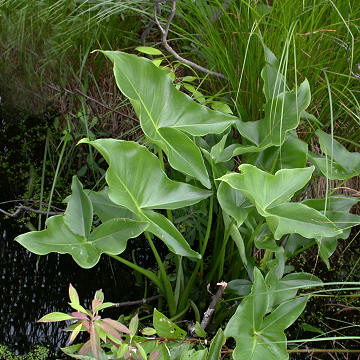

Peltandra virginica - (image 1 of 4)
Taxonomy
Family: Araceae
Habitat
Shallow water of swamps, bogs, ponds.
Associates
Distribution
Southern ME to FL, west to MI, MO, TX.
Morphology
Perennial from thick, fibrous, deeply buried roots. Leaves glabrous, all basal on long petioles, hastate or sagittate, the basal lobes acute and a third to half as long as the rest of the blade, pinnately veined. Flowers white to orange, covering a slender spadix within an elongate, greenish spathe on a scape 20-40 cm long; Spathe opening distally to expose the staminate flowers above while enclosing the pistillate flowers below. Fruit a cluster of green or browish, gelatinous berries, each containing 1-3 seeds.
Notes
Flowers June to July
Wetland indicator: Obligate
The root is starchy and can be used to make flour or as a root vegetable, but first requires thorough drying to break down calcium oxalate crystals which cause an intense burning sensation if ingested. Also called Tuckahoe, a term that can apply to a variety of plants utilized by Native Americans for food.
References
Gleason, Henry A. and A. Cronquist. 1991. Manual of Vascular Plants of Northeastern United States and Adjacent Canada. Second Ed.
The New York Botanical Garden. Bronx, NY
Peterson, L. A. 1977. A Field Guide to Edible Wild Plants: Eastern and central North America.
Houghton Mifflin Company. New York, NY
Swink, F. and G. Wilhelm. 1994. Plants of the Chicago Region.
Indiana Academy of Science. The Morton Arboretum. Lisle, Illinois.
|
Michael Hough © 2009 |